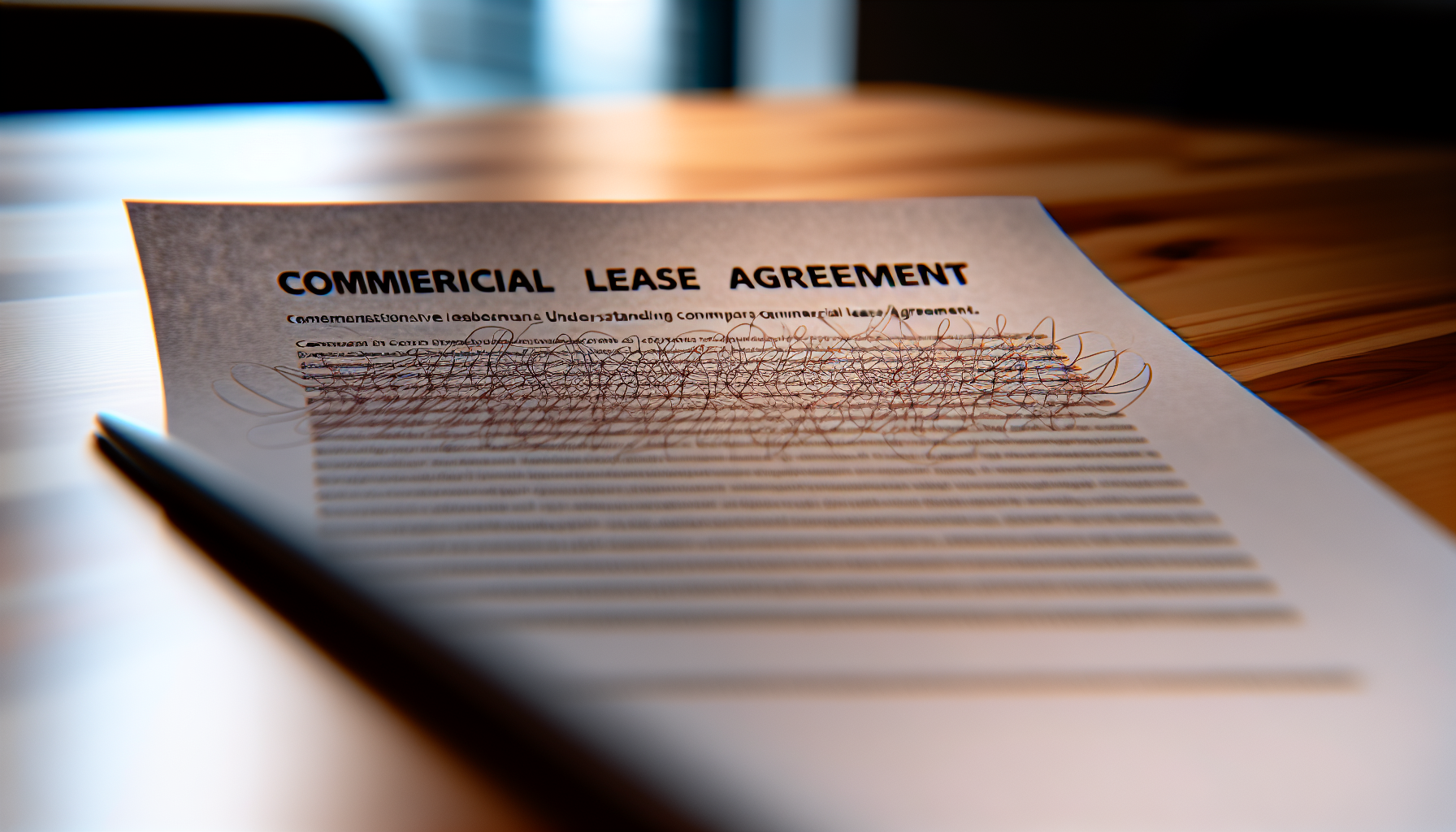Exploring what makes a robust commercial lease agreement and its impact on your business? This guide clarifies essential components, from party identification to rent and responsibilities, for both beginners and experts. Gain practical insights to ensure your next lease supports your business’s success.
Questioning what comprises a solid commercial lease agreement and its impact on your business? This concise guide demystifies the crucial elements, from identifying parties to outlining rent and legal responsibilities. Designed for both novice and experienced business professionals, it provides practical insights without overcomplicating the subject. Dive in to ensure your next commercial lease agreement aligns with your business’s security and success.
Key Takeaways
- Commercial lease agreements require detailed inclusion of key components such as party identification, premises description, and clear rent and payment terms, to ensure the agreement is enforceable and protects both parties’ interests.
- There are various types of commercial leases – gross, net, and specialized – that cater to different needs and allocate financial responsibilities differently between landlords and tenants.
- Proper commercial lease agreements should reflect localized legal requirements, include dispute resolution mechanisms, be customizable to the parties’ needs, and consider end-of-lease terms to ensure a smooth and prepared lease termination process.
Understanding Commercial Lease Agreements

A commercial lease agreement is more than just a legal document—it’s a roadmap for your business relationship with your landlord or tenant. This agreement not only defines the terms and conditions for the use and occupation of the commercial property for business purposes but also outlines the obligations each party must fulfill.
Bear in mind that commercial leases come with a higher level of complexity and legal obligation compared to residential leases. Although you can find free commercial lease agreement templates online, it’s imperative that they are customized to cater to the specific needs of the involved parties and abide by local laws and regulations. A sample commercial lease agreement can serve as a helpful starting point in this process.
Key Components of a Commercial Lease Agreement

In a commercial lease agreement, it is of the utmost importance to have all the details accurately and precisely defined. Paying such attention to detail helps avert potential future disputes or misunderstandings. Three key components form the backbone of any such agreement: the identification of parties involved, the description of the leased premises, and the outlining of rent and payment terms. These elements ensure that the agreement is enforceable and protects the interests of both the landlord and the tenant.
Identifying the Parties Involved
The first step in crafting a commercial lease agreement is accurately identifying the parties involved. This includes the full names and addresses of the landlord and tenant, as well as any guarantors or co-tenants. Guarantors play a significant role in a commercial lease agreement as they provide a guarantee that the tenant will meet their lease obligations. They can be either individuals or companies who assume financial responsibility for the lease if the tenant fails to fulfill their obligations.
Incorrect identification can result in severe legal consequences, thus getting it right from the beginning is paramount.
Describing the Leased Premises
The description of the leased premises should be as detailed as possible, providing specific details such as:
- The street address
- The exact square footage of the space
- A thorough description of the property itself
- Shared spaces such as lobbies, hallways, restrooms, and kitchens
- Any allocated parking spaces
This not only helps avoid future disputes but also ensures that both parties understand the extent of the property being leased.
Outlining Rent and Payment Terms
Terms regarding rent and payments in a commercial lease agreement should be clearly detailed. This includes:
- The monthly rent amount
- The due date for payment
- Any additional charges or responsibilities that the tenant may have for utilities, taxes, and insurance
The rent is typically determined by multiplying the rentable square footage of the property by the price per square foot.
Specifying the standard security deposit amount—often equivalent to one to three months’ rent—and detailing any extra costs or fees is also crucial.
Different Types of Commercial Leases Explained

Comprehending the various types of commercial leases can assist you in selecting the one that fits your needs the best. Commercial leases can be categorized into gross leases, net leases, and specialized lease types, each with its own payment structure and responsibilities.
Gross leases include all property-related expenses in the rent, while net leases require tenants to pay additional costs such as property taxes, insurance, and maintenance. Specialized lease types, on the other hand, cater to specific industries or property types.
The Gross Lease and Its Variations
A gross lease, also known as a full-service lease, enables the tenant to make a single payment that covers all operating expenses. This means the landlord assumes responsibility for property expenses like taxes, insurance, and maintenance, while the tenant pays a predetermined rent without incurring extra costs. In this arrangement, the tenant can conveniently pay rent in a hassle-free manner. However, this type of lease also comes with variations, such as a modified gross lease, where the landlord and tenant negotiate to determine which utilities each party will cover.
Net Lease Structures
Net leases, on the other hand, shift more responsibility to the tenant. Under this type of lease, the tenant pays not only the base rent but also additional expenses such as property taxes, insurance premiums, and even maintenance costs. The extent of these obligations can vary depending on whether the lease is a single, double, or triple net lease.
Specialized Lease Types
Specialized lease types cater to specific situations or property types. Here are a few examples:
- Percentage lease: requires the tenant to pay a base rent plus a percentage of their sales revenue, making it a common choice for retail businesses.
- Land lease: allows the tenant to develop a property while the landowner maintains ownership of the land.
- Net lease: requires the tenant to pay a base rent plus additional expenses such as property taxes, insurance, and maintenance costs.
- Gross lease: includes all expenses in the base rent, so the tenant does not have to pay additional costs.
- Triple net lease: requires the tenant to pay for property taxes, insurance, and maintenance costs in addition to the base rent.
These leases offer more flexible terms that can be tailored to the unique needs of the tenant’s business.
Tenant and Landlord Obligations

A commercial lease agreement involves mutual responsibilities, with both the landlord and tenant having specific obligations. These can include responsibilities for maintenance and repairs, insurance requirements, and rules for any alterations and improvements to the property.
These obligations help ensure that both parties fulfill their roles in maintaining the leased property and protecting their mutual interests.
Maintenance and Repairs
In terms of maintenance and repairs, the tenant shall be generally responsible for the interior of the property, carrying out regular repairs and routine maintenance. The landlord, on the other hand, is typically responsible for structural repairs, like those to the foundation and walls.
Failure to maintain the property can have serious consequences, including the potential termination of the lease.
Insurance Requirements
When it comes to insurance, the tenant is generally required to maintain commercial general liability insurance. This protects the tenant from potential claims related to bodily injury, property damage, and personal injury resulting from their business operations. The landlord, meanwhile, typically arranges for building insurance, which is a form of property insurance.
The standard requirements for a business tenant’s liability insurance usually consist of $1,000,000 for each occurrence and a general aggregate limit of $2,000,000.
Alterations and Improvements
Alterations and improvements to the property are another area where clear rules are needed. The lease agreement should outline the procedures for making changes to the property, including obtaining the landlord’s permission and restoring the space to its original condition at the end of the lease. This ensures that both parties are on the same page about any changes to the property and helps prevent disputes down the line.
Legal Considerations in Commercial Leasing

Beyond the terms and conditions stipulated in the lease agreement, both parties are required to comply with local laws and regulations. These can include zoning ordinances, building codes, and other local regulations.
It’s also crucial to include dispute resolution mechanisms in the lease agreement to avoid costly and time-consuming litigation.
Compliance with Local Laws
Keep in mind that a commercial lease agreement is not merely a contract between two parties—it must also align with local laws and regulations. This can include zoning ordinances, which determine permissible business types and property valuations, as well as building codes, which ensure that commercial structures are safe and compliant with health and environmental standards. Failing to comply with these laws can result in fines, legal conflicts, and other penalties, so it’s crucial to stay informed and compliant.
Dispute Resolution Mechanisms
Disputes can arise in any business relationship, and a commercial lease is no exception. For this reason, incorporating dispute resolution mechanisms in the lease agreement is crucial. These can range from:
- Mediation, where an impartial third party guides discussions between the disputing parties
- Alternative dispute resolution (ADR) strategies such as a comprehensive review and negotiation of the lease agreement
- Establishing clear communication
- Understanding rights and obligations
By including these mechanisms, you can effectively address and resolve any disputes that may arise during the lease term.
Having these mechanisms in place can help resolve disputes in a timely and cost-effective manner.
Customizing Your Commercial Lease
A commercial lease agreement is not a uniform document that fits all situations. It needs to be tailored to suit the specific needs of the landlord and tenant. This can include adding exclusivity and co-tenancy clauses to protect the tenant’s business interests, or incorporating provisions for subletting and assignment to provide flexibility for the tenant.
Exclusivity and Co-Tenancy
Exclusivity and co-tenancy clauses can be powerful tools for protecting a tenant’s business interests. An exclusivity clause prevents the landlord from leasing to competitors, giving the tenant the sole right to conduct a specific type of business or activity on the property.
On the other hand, a co-tenancy clause provides the tenant with the opportunity to potentially receive reduced rent if certain conditions are not fulfilled, such as:
- the termination of an anchor tenant’s lease
- a decrease in the number of customers visiting the shopping center
- a decrease in the overall occupancy rate of the shopping center
Subletting and Assignment
Subletting and assignment provisions offer another way to customize a commercial lease agreement. These allow the tenant to sublet the property or assign the lease to another party, subject to the landlord’s approval. This can provide flexibility for the tenant, especially if their business needs change during the term of the lease.
However, it’s important to follow the proper procedures for subletting or assignment, including obtaining the landlord’s written consent and drafting a sublease or assignment agreement with the new tenant.
Preparing for Lease Termination
Even though it might seem early to contemplate the lease’s end before it has even started, planning for lease termination forms an integral part of any commercial lease agreement. The agreement should outline the conditions for early termination, options for renewal, and the process for returning the property to its original condition.
Preparing for lease termination can help avoid surprises and ensure a smooth transition at the end of the lease term.
Protecting Your Interests: Negotiation Tips
Having grasped the key elements of a commercial lease agreement, you’re now ready to negotiate. Whether you’re a landlord or tenant, it’s important to protect your interests during this process. This could involve requesting a rent-free period, exploring tenant incentives, and presenting a redlined lease with suggested modifications.
Remember, a lease agreement is a negotiation, not a take-it-or-leave-it proposition. Don’t be afraid to ask for what you want and need.
Summary
In conclusion, understanding the elements of a commercial lease agreement is crucial for both landlords and tenants. It not only sets the groundwork for your business relationship, but also provides legal protection for both parties. From identifying the parties involved to preparing for lease termination, each element plays a critical role in shaping the agreement. Don’t be afraid to negotiate and customize the lease to suit your specific needs—after all, a well-negotiated lease is the foundation of a successful landlord-tenant relationship.
Frequently Asked Questions
What is the most common commercial lease agreement?
The most common commercial lease agreement is a gross lease, which is typically used for offices and retail space. It involves the tenant paying a single, flat amount that covers rent, taxes, utilities, and insurance.
How do you write a commercial lease proposal?
Include the following 8 sections in your commercial property proposal: Lease Term or Lease Type, Rent obligations, Security Deposit, Permitted Use or Exclusive Use Clauses, Maintenance and utilities, Personal Guarantee, Amendments, Modifications, or Termination Clauses, and Substances. This will provide a comprehensive overview of your proposed lease terms.
What clauses are in a commercial lease?
A commercial lease typically includes clauses such as Permitted Use/Use Clause, Condition of the premises/Landlord’s Work/Tenant’s Work, Repairs and Maintenance Clause, Assignment and Subleasing Clause, and Default Clause. These are common terms you should be familiar with.
What is the meaning of commercial lease agreement?
A commercial lease agreement is a contract for a business to rent an office space or other business property from a landlord, and it is specifically for business activities rather than housing.
What are the key components of a commercial lease agreement?
The key components of a commercial lease agreement are identifying the involved parties, describing the leased premises, and outlining rent and payment terms. These components are essential for a comprehensive and clear agreement.


